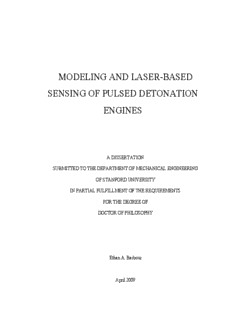
Barbour, Ethan A. (2009). PDF
Preview Barbour, Ethan A. (2009).
MODELING AND LASER-BASED SENSING OF PULSED DETONATION ENGINES A DISSERTATION SUBMITTED TO THE DEPARTMENT OF MECHANICAL ENGINEERING OF STANFORD UNIVERSITY IN PARTIAL FULFILLMENT OF THE REQUIREMENTS FOR THE DEGREE OF DOCTOR OF PHILOSOPHY Ethan A. Barbour April 2009 © Copyright by Ethan A. Barbour 2009 All Rights Reserved ii This dissertation is dedicated to my beautiful wife Shengmei. Her love, patience and encouragement have enabled me to achieve more than what I could have ever imagined. iii iv I certify that I have read this dissertation and that, in my opinion, it is fully adequate in scope and quality as a dissertation for the degree of Doctor of Philosophy. ________________________________ (Ronald K. Hanson) Principal Adviser I certify that I have read this dissertation and that, in my opinion, it is fully adequate in scope and quality as a dissertation for the degree of Doctor of Philosophy. ________________________________ (Craig. T. Bowman) I certify that I have read this dissertation and that, in my opinion, it is fully adequate in scope and quality as a dissertation for the degree of Doctor of Philosophy. ________________________________ (Christopher M. Brophy) Approved for the Stanford University Committee on Graduate Studies. v vi Abstract This work is concerned with two major aspects of pulse detonation engines (PDE) research: modeling and laser-based sensing. The modeling addresses both ideal and real considerations relevant to PDE design. First, an ideal nozzle model is developed which provides a tool for choosing area ratios for fixed-geometry converging, diverging, or converging-diverging nozzles. Next, losses associated with finite-rate chemistry are investigated. It was found that PDEs can experience up to ~ 10% reduction in specific impulse from this effect if O is used as the oxidizer, whereas the losses are negligible for 2 air-breathing applications. Next, heat transfer and friction losses were investigated and found to be greater than the losses from simple straight-tube PDEs. These losses are most pronounced (~ 15%) when converging nozzles are used. The second portion of this work focuses on laser-based absorption sensing for PDEs. The mid-infrared was chosen as the best way to address the challenges of signal-to-noise ratio, sensitivity, robustness, and sensor bandwidth. A water vapor sensor was developed and applied to the PDE at the Naval Postgraduate School. This sensor provided improvements in temperature accuracy, and it revealed that water (generated by the vitiator) inhibited performance of the engine. Next, a JP-10 absorption sensor was developed and applied to the same engine. This sensor provided thermometry data at a higher temporal resolution than the water sensor. The sensor also provided crucial information on equivalence ratio and fuel arrival time which enabled the engine to be successfully operated on JP-10 and air for the first time. vii viii Acknowledgements First and foremost, I would like to thank my advisor, Prof. Ronald Hanson. His guidance, encouragement, and wisdom have shaped me greatly over the past several years. I have grown not only as a scientifically minded individual, but also as an academic, an engineer, an educator, an entrepreneur, and as a manager. I have also grown personally, learning from his examples on how to best balance my professional and family lives. His guidance has more than prepared me for my life post-Stanford. I would also like to acknowledge the other members of my reading committee, Prof. C. T. Bowman, and Prof. Christopher Brophy. Prof. Bowman has had a large influence on my abilities as an engineer through his lucid explanations of the many concepts he has covered in the classroom setting. Prof. Brophy has been a wonderful friend and colleague ever since my first measurement campaign to Monterey. Of course, my research would have been much more difficult without the help of Dr. Dave Davidson and Dr. Jay Jeffries. These two gentlemen were always willing and able to help me through any kind of problem, while still having time for the dozens of other students in need of their assistance. A special thanks to Dave for our many long and fascinating discussions on the subtleties of the spirit. So many others deserve thanks. My parents, Brian and Anne, raised me to pursue what interests me, and I therefore owe my time at Stanford to them. My brothers, Lyall and Jesse, have always been a source of levity. My parents-in-law, Lidong Zhang and Yan Zhao, have provided much encouragement and great enthusiasm. I owe all of my machining knowledge to Scott, Lakhbir and Bill. My many friends have made the tough times easy: Rob (for teaching me about the joys of apathy), Greg (for always being able to lighten the office mood), Zach (for showing me that scientists can be hip), Dan H. (for his shared interest in the strange), Pedram (for his neverending randomness) and Giancarlo (our gigs were some of the best). Of course I can’t forget Matei, Venky, Dave R., Dave J., Chico (a-Hoy-Hoy), Franz, Ben G., Matt O., Matt B., Dan M. (2x), Subith, Megan, Genny, Zekai, Brian C., Shannon, Eric, Ben W. (BN), Aamir (Salaam 'Alaykum), Jason, Brian L., Kent, Andrew, John, Dan S., Mike and Gabe. ix x
Description: